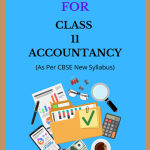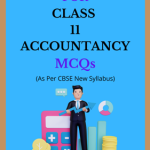NCERT Class 11 Accountancy MCQ Chapter 3 Recording of Transactions-I Solutions, AHSEC Class 11 Accountancy Multiple Choice Question Answer to each chapter is provided in the list so that you can easily browse throughout different chapters NCERT Class 11 Accountancy MCQ Chapter 3 Recording of Transactions-I Question Answer and select needs one.
NCERT Class 11 Accountancy MCQ Chapter 3 Recording of Transactions-I
Also, you can read the AHSEC book online in these sections NCERT Class 11 Accountancy Multiple Choice Solutions by Expert Teachers as per AHSEC (CBSE) Book guidelines. AHSEC Class 11 Accountancy MCQ Solutions. These solutions are part of AHSEC All Subject Solutions. Here we have given HS 1st Year Accountancy Objective Type Question Answer for All Subjects, You can practice these here.
Recording of Transactions-I
Chapter: 3
| PART – Ⅰ |
MULTIPLE CHOICE QUESTION ANSWER
1. Voucher is prepared for:
(i) Cash received and paid.
(ii) Cash/Credit sales .
(iii) Cash/Credit purchase.
(iv) All of the above
Ans: (iv) All of the above.
2. Liabilities and Assets amount to Rs. 50,000 and Rs. 7,800 respectively. The difference Amount shall represent-
(i) Creditors.
(ii) Debentures.
(iii) Profit.
(iv) Capital.
Ans: (iv) Capital.
3. Voucher is prepared from:
(i) Documentary evidence.
(ii) Journal entry.
(iii) Ledger account.
(iv) All of the above.
Ans: (i) Documentary evidence.
4. Liabilities and Assets amount to Rs. 50,000 and Rs. 7,800 respectively. The difference Amount shall represent-
(i) Creditors.
(ii) Debentures.
(iii) Profit
(iv) Capital.
Ans: (iv) Capital.
5. A company pays Rs.2,000 for a one-year insurance policy in advance. What is the journal entry at the time of payment?
(i) Debit Insurance Expense Rs.2,000; Credit Cash Rs.2,000
(ii) Debit Prepaid Insurance Rs.2,000; Credit Cash Rs.2,000
(iii) Debit Cash Rs.2,000; Credit Insurance Expense Rs.2,000
(iv) Debit Cash Rs.2,000; Credit Prepaid Insurance Rs.2,000
Ans: (ii) Debit Prepaid Insurance Rs.2,000; Credit Cash Rs.2,000
6. Issued a cheque for ₹8,000 to pay rent. The account to be debited is:
(i) Rent Expense.
(ii) Cash.
(iii) Bank.
(iv) Accounts Payable.
Ans: (i) Rent Expense.
7. A purchase of machine for cash should be debited to:
(i) Cash account.
(ii) Machine account.
(iii) Purchase account.
(iv) None of these.
Ans: (ii) Machine account.
8. Which of the following is correct?
(i) Liabilities = Assets.
(ii) Assets + Capital = Liabilities– Capital .
(iii) Capital = Assets – Liabilities.
(iv) Capital = Assets + Liabilities.
Ans: (iii) Capital = Assets – Liabilities.
9. Collected ₹35,000 from debtors. The account to be credited is:
(i) Debtors.
(ii) Cash.
(iii) Sales.
(iv) Bank.
Ans: (ii) Cash.
10. Cash withdrawn by the Proprietor should be credited to:
(i) Drawing account.
(ii) Capital account.
(iii) Profit and loss account.
(iv) Cash account.
Ans: (i) Drawings account.
11. Issued a cheque for Rs.70,000 to pay off one of the creditors. The account to be debited is:
(i) Cash.
(ii) Bank.
(iii) Accounts Payable.
(iv) Creditors.
Ans: (iii) Accounts Payable.
12. Find the correct statement:
(i) Credit a decrease in assets.
(ii) Credit the increase in expenses.
(iii) Debit the increase in revenue.
(iv) Credit the increase in capital.
Ans: (iv) Credit the increase in capital.
13. The book in which all accounts are maintained is known as:
(i) Cash Book.
(ii) Journal.
(iii) Purchases Book.
(iv) Ledger.
Ans: (iv) Ledger.
14. Recording of transaction in the Journal is called:
(i) Casting.
(ii) Posting.
(iii) Journalising.
(iv) Recording.
Ans: (iii) Journalising.
15. What are the five categories of ledger accounts?
(i) Assets, Liabilities, Revenue, Expenses, and Drawings.
(ii) Assets, Liabilities, Capital, Revenues/Gains, and Expenses/Losses.
(iii) Assets, Equity, Liabilities, Income, and Expenses.
(iv) Assets, Debts, Equity, Gains, and Losses.
Ans: (ii) Assets, Liabilities, Capital, Revenues/Gains, and Expenses/Losses.

Hi! my Name is Parimal Roy. I have completed my Bachelor’s degree in Philosophy (B.A.) from Silapathar General College. Currently, I am working as an HR Manager at Dev Library. It is a website that provides study materials for students from Class 3 to 12, including SCERT and NCERT notes. It also offers resources for BA, B.Com, B.Sc, and Computer Science, along with postgraduate notes. Besides study materials, the website has novels, eBooks, health and finance articles, biographies, quotes, and more.





